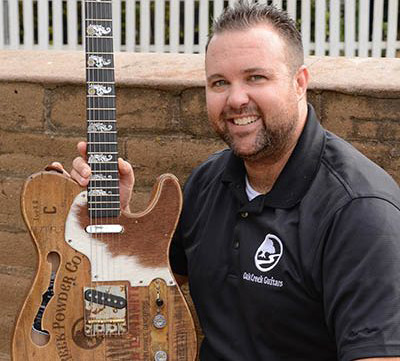
Josh Stotler made his first guitar at age 14, in his parents’ laundry room. “I couldn’t afford a guitar and, having no prior woodworking experience, decided to make one. It was all done with hand tools, no power tools except for a sander.”
It came out well — serving as his instrument for a high school Battle of the Bands – and he still owns and is proud of it, but it’s also fair to say that Josh’s guitar making has come a long way since then.
These days, he runs Oak Creek Guitars as a part-time business in addition to working full-time as a carpenter for a construction company, and regularly enters (and wins) in the themed competition for the Design in Wood show at the San Diego County Fair. Most recently, his 2018 entry won the Theme award for a “Willy Wonka Jumbo Body Guitar.”
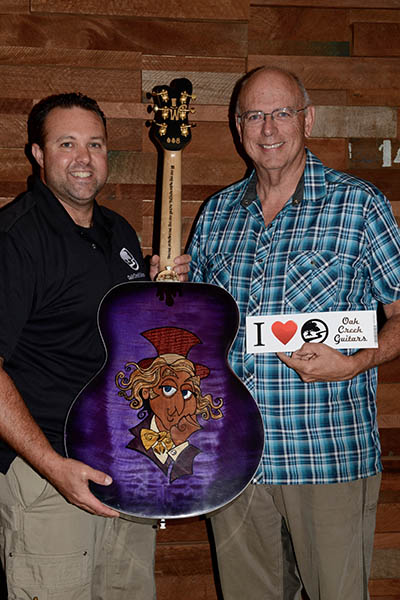
There was a gap between Josh’s first guitar and his next efforts, which came about while he was on a military base in Germany. Having read books on guitar building and theory, he built a semi-hollow body guitar with bent sides and carved neck in the base woodshop. “That one came out leaps and bounds better than the first one,” Josh said. And, with all of the comings and goings as people moved in and out of the military community, “a lot of broken musical instruments wind up coming there, so I kind of found a little niche market in doing guitar repairs,” Josh said.
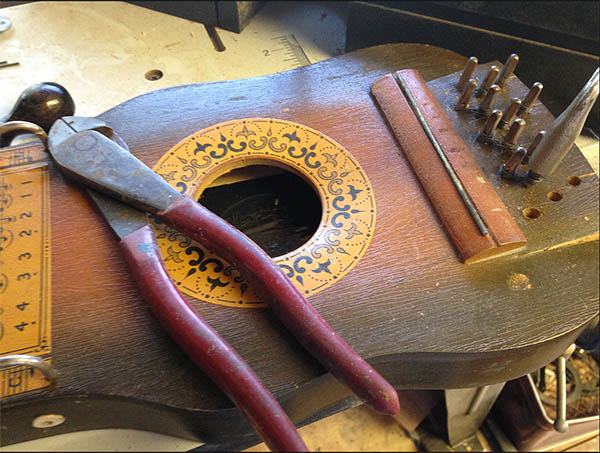
He still also does restoration work in addition to building custom and themed guitars, noting that he really enjoys restoration. “I take on the ones that most people won’t touch, because either the guitar is too far gone or they don’t want to risk ruining a historic instrument. Those are the things I really excel on. I will take that and do my thing and bring back a guitar that probably would never have played again.”
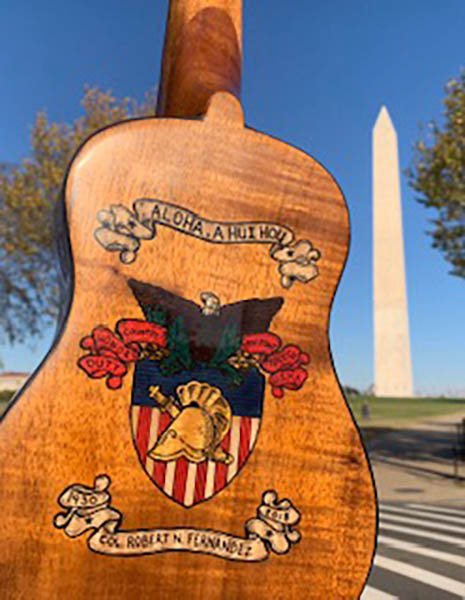
Most recently, he restored a Kamaka ukulele that his best friend’s father had purchased in Hawaii in the 1950s. “The hide glue was crystallized; the wood was very dry; it had wear from being played so much so the top was starting to separate from the sides.” Working with Kamaka Ukulele and the United States Military Academy at West Point, Josh both repaired the instrument and adorned it with the West Point crest on the back, the father’s retired rank of colonel on the fretboard and Hawaii’s Diamond Head on the headstock for presentation at the funeral at Arlington National Cemetery.
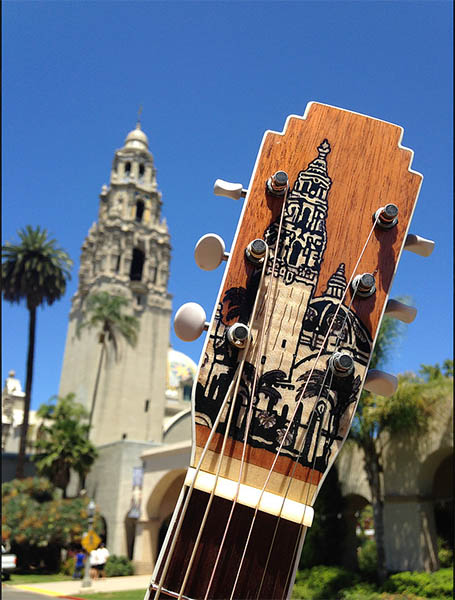
“I absolutely love doing inlay,” Josh said. “I basically make a guitar so I can inlay them.” He doesn’t limit himself when it comes to inlay material, having used mother-of-pearl, abalone, metal and resin, either tinted or clear to simulate water. Resin pen turning blanks in different colors and materials are a favorite option. He also uses wood for inlay: “I will use any type of wood, keeping in mind that they do react differently when they are paired together – but usually the inlays are so thin that flexing and warping is not an issue, especially when you get a clear coat on it.”
His first step in creating a guitar is to sketch out his designs, with the back, the top and the headstock being the three major areas he focuses on for inlay. Then he’ll research, and eventually fine-tune his drawings to exactly what he wants. “Then I just use copies of that, full-scale to cut out my inlay pieces, and then I rout and glue everything down from that master drawing.”
Josh has graduated from laundry room building to a dedicated shop, with, as he said, “thousands of tools that go into building a guitar.” He’s also built a couple of jigs and fixtures himself to speed along the process: a fret-slot cutting jig that gives him accurate depth and spacing of the frets for the fretboard and a side bending machine for the guitar sides.
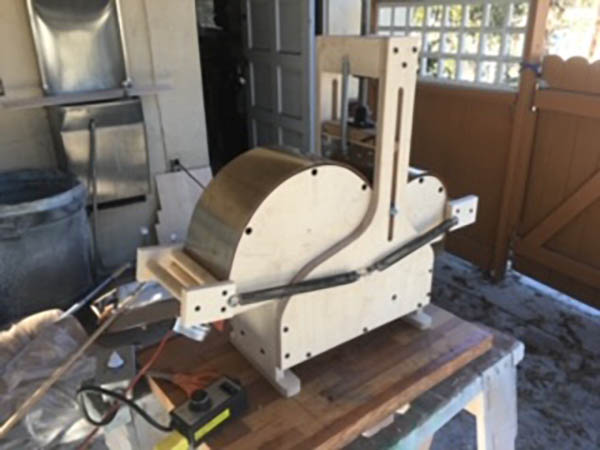
The latter is the latest iteration in his bending technique. At first, “I used to use a spray bottle full of water and a pipe that I heated with a torch.” He then graduated to an electronically bending iron with temperature control and a teardrop shape to allow the creation of sweeping sides or sharp radii. His latest upgrade is to the side bending machine: “It incorporates a form in the shape of one half of the guitar side, and I lay the wood on there with an electronically heated blanket, and then use a screwed auger to push down in the waist of the guitar and then clamps to hold the sides into place. So it’s a form that utilizes heat and moisture to hold the sides. I can get very specific, accurate and consistent sides with that machine in a matter of minutes, where it would take me hours to hand bend one side.”
Some of the most recent guitars he’s built with his apparatus include one he’s working on, made from black walnut from his grandparent’s San Diego property that was harvested after the tree was damaged in one of the recent wildfires. Plus, he also recently made a replica of country singer Willie Nelson’s 1963 Sitka spruce Martin guitar, “Trigger.”
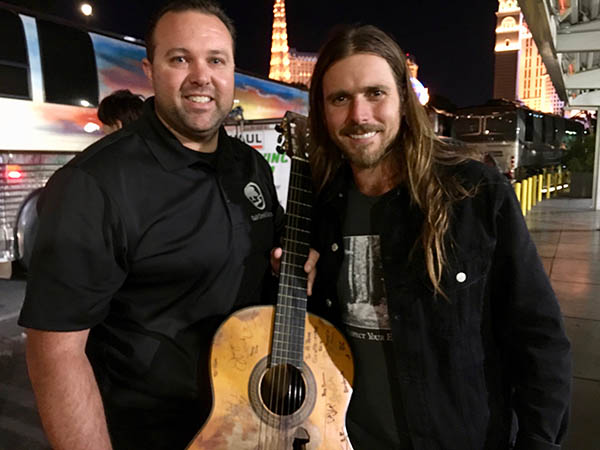
“His guitar is very famous for looking the way it does. He’s actually worn a hole in the front of it. I’ve always been a fan of his guitar, so I made a replica and took it to have him sign it.” While Josh didn’t get to meet Willie himself, he did meet Willie’s son, Lukas Nelson, who was impressed by the guitar’s similarity to the original – and, by contacting the person who repairs those guitars, he was able to acquire pieces of the original Trigger that he incorporated into the replica: “Some tuners and a couple pieces of guitar string that were on the original and a couple chips of wood, so it was pretty neat.”
Josh is also working on his entry for the 2019 Design in Wood show. The theme was recently announced as “Oz-some,” inspired by The Wonderful Wizard of Oz. “Sometimes it comes down to the wire; I joke that I’m often holding the guitar outside the window to try to let the finish dry on my way to the Fair,” Josh said.
In total, he has so far made 13 complete guitars, eight of which have been for the San Diego County Fair. “I have a book of all my original drawings for each guitar. It’s something that’s pretty special to me,” he said.







